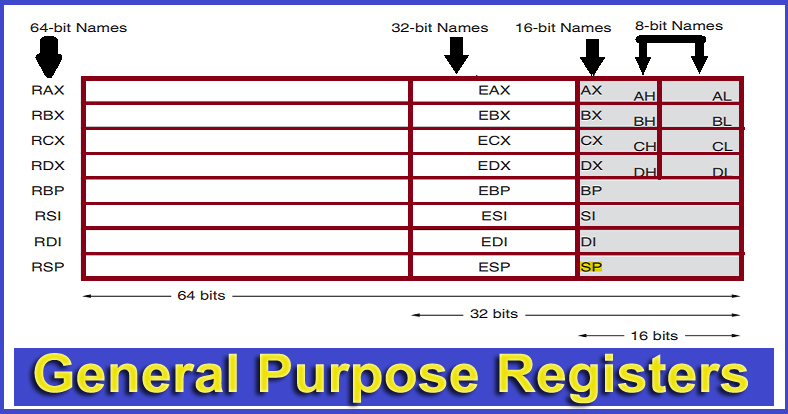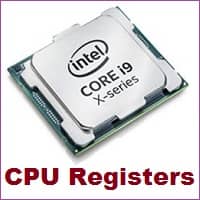Hello Learners! Today, we will explain all possible stuffs about what is general purpose registers with their example; as well as special purpose registers with ease. This is unique content over the internet; making ensure that at the end of this post; you will definitely completely understand about General Purpose Registers without getting any obstacle.
What is General Purpose Registers?
General Purpose Registers (GPRs) are essential components in CPU that using for several purposes, including storing data, memory addresses, and operands for arithmetic and logical operations. They serve as a quick memory for data and instructions needed by the CPU. In the x86 architecture, eight GPRs are using, such as AX, BX, CX, DX, SI, DI, BP, and SP. These registers allow keeping storing and manipulating data, executing arithmetic and logical operations, as well as facilitating memory addressing.
GPRs are opposite to Special Purpose Registers (SPRs), because they have specific functions and are not as versatile. The specific GPR used in assembly language instructions depends on the context and the performing operations.
‘General Purpose Registers’ Tutorial Headlines:
In this section, we will show you all headlines about this entire article; you can check them as your choice; below shown all:
- What is General Purpose Registers?
- General Purpose Registers Functions
- General Purpose Registers in 8086 with Examples
- General Purpose Registers in 8085 with Examples
- General Purpose Registers in 8051 with Examples
- Special Purpose Registers
- Difference between General and Special Purpose Registers
- FAQs (Frequently Asked Questions)
- What is the purpose of General Purpose Registers in CPU?
- Can General Purpose Registers be directly accessed by programmers in high-level languages?
- Can General Purpose Registers be used for floating-point operations?
- How are Special Purpose Registers different from General Purpose Registers?
Let’s Get Started!!
General Purpose Registers Functions
General-purpose registers (GPRs) serve several functions in your CPU’s architecture and supporting fundamental operations during program execution. Here are some key functions of general-purpose registers, including:
Data Storage: GPRs store temporary data during program execution, providing quick access for the CPU to perform calculations and operations
Arithmetic Operations: GPRs use for arithmetic operations such as addition, subtraction, multiplication, and division. They store operands and results of these operations.
Logical Operations: GPRs facilitate logical operations like AND, OR, and XOR, helping the CPU make decisions based on conditions.
Memory Address Calculation: GPRs may hold memory addresses or offsets, aiding in the calculation of addresses for data retrieval and storage in RAM.
Function Return Values: GPRs often store return values from function calls, allowing the CPU to pass information back to the calling code.
Loop Counters: Specific registers, like ECX in x86 architecture, are commonly using as loop counters, facilitating iterative operations.
Shift and Rotate Operations: GPRs involve in shifting and rotating bits within data, supporting various bitwise operations.
Context Switching: During context switching between different tasks or processes, the contents of GPRs saved and restored to maintain the state of a process.
Pointer Operations: Some GPRs, like EBX in x86, may serve as base pointers for memory access or hold addresses.
Temporary Storage: GPRs act as temporary storage for intermediate values, aiding in complex calculations and data manipulation.
General Purpose Registers in 8086 with Examples
The Intel 8086 microprocessor introduced in 1978; it has eight general-purpose registers. Each of these registers can use as a whole 16-bit register or as two separate 8-bit registers. These registers are using for various purposes in programming, such as storing data, addressing memory, and performing arithmetic operations.
Also Read: What is CPU and its Components? Parts of CPU and Their Functions
The primary general-purpose registers in the 8086 are AX, BX, CX, and DX.
AX (Accumulator)
AX can use as a 16-bit register or as two separate 8-bit registers, AH (high byte) and AL (low byte).
Example: MOV AX, 1234h ; Move the hexadecimal value 1234h into AX
BX (Base)
Like AX, BX use as a 16-bit register or as two separate 8-bit registers, BH (high byte) and BL (low byte).
Example: MOV BX, 5678h ; Move the hexadecimal value 5678h into BX
CX (Count)
CX serves as a counter and using as a 16-bit register or as two separate 8-bit registers, CH (high byte) and CL (low byte).
Example: MOV CX, 10 ; Move the value 10 into CX
DX (Data)
DX is using for general data operations and can also use as a 16-bit register or as two separate 8-bit registers, DH (high byte) and DL (low byte).
Example: MOV DX, 0ABCh ; Move the hexadecimal value 0ABCh into DX
Other General-Purpose Registers (SI, DI, BP, and SP):
SI register is the source index register and is using to point to the source in some string-related operations.
DI register is the destination index register and uses to point to the destination in some string-related operations.
BP register is the base pointer and is primarily using in accessing the parameters passed by the stack.
SP register is the stack pointer and points to the topmost element of the stack.
General Purpose Registers in 8085 with Examples
The 8085 microprocessor has six general-purpose registers, labelled B, C, D, E, H, and L. These registers can be paired to form three register pairs: BC, DE, and HL. Each register is 8 bits wide, and the register pairs are 16 bits wide.
Here are the general-purpose registers in the 8085 microprocessor:
- B Register: The high-order byte of the BC register pair
- C Register: The low-order byte of the BC register pair
- D Register: The high-order byte of the DE register pair
- E Register: The low-order byte of the DE register pair
- H Register: The high-order byte of the HL register pair
- L Register: The low-order byte of the HL register pair
Features of GPR of 8085 include:
All registers are directly accessible by the arithmetic and logic unit, allowing for efficient processing of data.
The accumulator register uses as a default destination for most arithmetic operations.
Examples Are:
Moving Data Between Registers
MOV B, A ; Move the contents of the accumulator (A) to the B register
MOV C, B ; Move the contents of the B register to the C register
In this example, the MOV instruction uses to transfer data between the accumulator and the B register, and then from the B register to the C register.
Register Pair Operations
MVI H, 0AH ; Load the immediate value 0AH into the H register
MVI L, 05H ; Load the immediate value 05H into the L register
Here, the MVI (Move Immediate) instruction is using to load immediate data into the H and L registers, forming the HL register pair.
Addition of Register Pairs
MOV B, 10 ; Load value 10 into the B register
MOV C, 20 ; Load value 20 into the C register
ADD B ; Add the contents of the B register to the accumulator
This example demonstrates loading values into the B and C registers and then adding the contents of the B register to the accumulator.
General Purpose Registers in 8051 with Examples
The 8051 microcontroller has four banks of general-purpose registers, denoted as B0, B1, B2, and B3, each containing eight registers ranging from R0 to R7. These registers are using to store the output of mathematical and logical instructions, and they are of 8 bits in size.
In addition to the general-purpose registers, the 8051 also has other widely used registers such as the accumulator (A), B, data pointer (DPTR), and program counter (PC). These registers can use for various purposes, such as storing data, performing arithmetic operations, and holding temporary values.
R0 and R1
- These are 8-bit registers use for general-purpose storage.
- They can also use in arithmetic and logical operations.
Example:
- MOV A, #50 ; Load the accumulator A with the value 50
- MOV R0, A ; Move the contents of A to R0
- ADD A, R0 ; Add the contents of R0 to A
R2 and R3
- These are also 8-bit registers using for general-purpose storage.
- They can also use similarly to R0 and R1.
Example:
- MOV A, #30 ; Load the accumulator A with the value 30
- MOV R2, A ; Move the contents of A to R2
- SUBB A, R2 ; Subtract the contents of R2 from A with borrow
Special Purpose Registers
Special Purpose Registers (SPRs) are registers within a computer’s central processing unit (CPU) that help to serve dedicated functions instead of general-purpose registers. These registers are designed to control specific aspects of the processor’s behavior, manage system configuration, or facilitate certain operations. The exact set of special purpose registers can vary between different CPU architectures.
Also Read: What is CPU Register? Types of CPU Registers and Their Functions
Here are some common types of special purpose registers with examples:
Program Counter (PC)
Purpose: Keeps track of the memory address of the next instruction to be executed.
Example: x86 architecture uses the EIP (Extended Instruction Pointer) as the program counter.
Stack Pointer (SP)
Purpose: Points to the top of the stack in memory, used for managing subroutine calls and local variables.
Example: x86 architecture uses ESP (Extended Stack Pointer) as the stack pointer.
Status Register (Flags Register)
Purpose: Stores various condition flags resulting from arithmetic and logical operations.
Example: x86 architecture has the FLAGS register, with bits representing conditions like zero, carry, overflow, etc.
Instruction Pointer (IP)
Purpose: Similar to the program counter, it holds the memory address of the next instruction to be executed, particularly in the context of x 86 real modes.
Memory Address Register (MAR)
Purpose: Holds data fetched from or to be written to memory.
Example: Used in the memory read or write cycle to temporarily store data being transferred between the CPU and memory.
Machine Status Register (MSR)
Purpose: Controls various machine-specific operating modes and settings.
Example: Found in PowerPC architecture, the MSR might have bits controlling interrupt enable/disable, floating-point unit modes, and other machine-specific settings.
Control Register (CR)
Purpose: Contains control information for the CPU, such as enabling or disabling certain features.
Example: x86 architecture has control registers like CR0 and CR4, which control features like paging, protection, and task switching.
Debug Registers (DR)
Purpose: Used for hardware debugging, allowing breakpoints and watchpoints to be set.
Example: x86 architecture has DR0 to DR7, which can be configured for debugging purposes.
Floating-Point Control and Status Registers (FPSCR)
Purpose: Manages floating-point operations and stores status flags.
Example: PowerPC architecture uses FPSCR for floating-point control and status information.
Vector Registers
Purpose: Used for SIMD (Single Instruction, Multiple Data) operations.
Example: In architectures like Intel’s x86 (with SSE, AVX), ARM NEON, or IBM’s AltiVec, vector registers hold multiple data elements for parallel processing.
Difference between General and Special Purpose Registers
Here, we will show you a tabular comparison of General Purpose Registers (GPRs) and Special Purpose Registers (SPRs):
Aspect | General Purpose Registers | Special Purpose Registers |
Function | Used for general data manipulation | Designed for specific tasks and functions |
Versatility | Versatile, can be used for various tasks | Specialized, dedicated roles within the CPU |
Number | Usually multiple (e.g., 8 to 32) | Typically fewer, with specific functions |
Access by Programmers | Directly accessed in low-level languages | Indirectly accessed through compiled code |
Types | May include integer and floating-point registers | Program Counter (PC), Stack Pointer (SP), Status Register, etc. |
Usage in Arithmetic Operations | Used for general arithmetic operations | Flags in Status Register indicate results of operations |
Role in Memory Addressing | Can be used for holding memory addresses | Special Purpose Registers like Memory Address Register (MAR) and Memory Buffer Register (MBR) are used for memory operations |
Impact on Program Performance | Efficient use can improve performance by minimizing memory access | Essential for control flow, interrupt handling, and managing program state |
Context Switching | Content needs to be saved and restored during context switches | Part of the context that needs to be saved and restored during context switches |
Examples (x86 Architecture) | EAX, EBX, ECX, EDX | Program Counter (PC), Flags Register, Stack Pointer (SP) |
Programming Languages | Accessed in low-level and assembly languages | Accessed indirectly in high-level languages through compiler-generated code |
FAQs (Frequently Asked Questions)
What is the purpose of General Purpose Registers in CPU?
GPRs are used to store temporary data and intermediate results during program execution. They play a crucial role in arithmetic and logic operations, as well as in holding memory addresses and data for efficient data manipulation.
Can General Purpose Registers be directly accessed by programmers in high-level languages?
In high-level languages, programmers usually work with variables, and the compiler manages the mapping of these variables to registers. However, some low-level programming languages or assembly languages allow direct access to GPRs for more precise control over the processor.
Can General Purpose Registers be used for floating-point operations?
Some GPRs are designated for integer operations, while others may be specifically designed for floating-point operations. Processors may have separate sets of registers for integer and floating-point operations.
How are Special Purpose Registers different from General Purpose Registers?
Special Purpose Registers are used to perform the certain functions, like as control and status information. But, General Purpose Registers are more versatile and can be used for a large range of tasks for data manipulation.
Final Words
Now, we can hope that you have been completely educated about what is general purpose registers with their example; as well as special purpose registers with ease. If this article is helpful for you, and then please share it along with your friends, family members or relatives over social media platforms like as Facebook, Instagram, Linked In, Twitter, and more.
Also Read: What is Motherboard? Function, Components and Types of Motherboard
If you have any experience, tips, tricks, or query regarding this issue? You can drop a comment!
Happy Learning!! 





